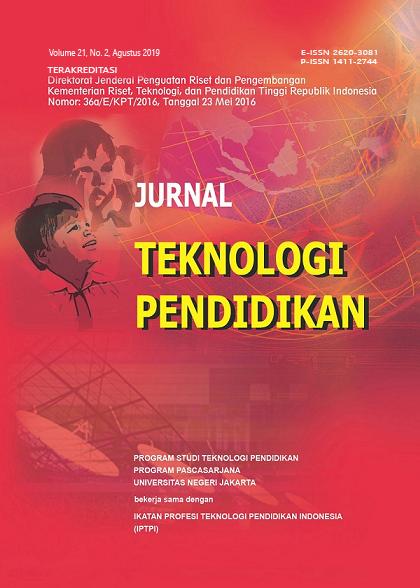Pengembangan Media Pembelajaran Interaktif Berbasis Video Tutorial Di Sekolah Menengah Kejuruan
DOI:
https://doi.org/10.21009/jtp.v21i2.11568Keywords:
research and development, video tutorial, interactive media, multimedia, camtasia studioAbstract
Abstract: The rapid exchange of information through multimedia throughout the world helps the growth of humans’ knowledge and, at the same time, requires redefinition of learning methods and media, especially in the field of vocational education. The purpose of this research was to develop an interactive learning media in the form of video tutorial in increasing the learning effectiveness in the subject of audio processing techniques at class XII in multimedia competence in one of the State Vocational Schools in Parepare. Research and Development method was used in this study. The stages of research included the planning, design and development stages. The subjects engaged in this research were two validators namely the experts of learning media and learning material, the students of class XII multimedia with the total of 18 persons, and one teacher who taught audio processing techniques. The results achieved in the development of interactive media showed that the developed video tutorial media had been valid based on the assessment of both learning media and learning material experts. The tests conducted on individuals, small group trials, and the subject teacher’s responses indicated that an interactive media in the form of video tutorial was effective and appropriate to the users’ needs.
Keywords: Research and development, Video Tutorial, Interactive media, Multimedia, Camtasia Studio
Abstrak: Pertukaran informasi yang cepat melalui multimedia di seluruh dunia membantu pertumbuhan pengetahuan manusia dan, pada saat yang sama, membutuhkan pendefinisian ulang metode dan media pembelajaran, terutama di bidang pendidikan kejuruan. Tujuan penelitian yaitu untuk mengembangkan media interaktif berupa video tutorial pembelajaran dalam meningkatkan efektivitas pembelajaran pada mata pelajaran teknik pengolahan audio kelas XII kompetensi keahlian multimedia di salah satu SMK Negeri di Parepare. Penelitian ini merupakan penelitian dan pengembangan (Research and Development). Tahapan penelitian meliputi tahap perencanaan, desain dan pengembangan. Subjek penelitian yang digunakan pada studi ini meliputi dua orang validator yaitu ahli media pembelajaran dan ahli materi pembelajaran, siswa kelas XII multimedia yang berjumlah 18 orang dan satu orang guru mata pelajaran teknik pengolahan audio. Hasil yang dicapai dalam pengembangan media interaktif menunjukkan media vidio tutorial yang dikembangkan telah valid berdasarkan penilaian dari ahli media pembelajaran dan ahli materi. Uji coba yang dilakukan kepada perorangan, uji coba kelompok kecil, dan tanggapan guru mata pelajaran menunjukkan bahwa media interaktif berupa video tutorial pembelajaran yang dihasilkan efektif dan sesuai kebutuhan pengguna.
Keywords: Pengembangan, Video tutorial, Media Interaktif, Multimedia, Camtasia Studio
Downloads
Published
How to Cite
Issue
Section
License
Jurnal Teknologi Pendidikan is an Open Access Journal. The authors who publish the manuscript in Jurnal Teknologi Pendidikan agree to the following terms.
Attribution-ShareAlike 4.0 International (CC BY-SA 4.0)
-
Attribution — You must give appropriate credit, provide a link to the license, and indicate if changes were made. You may do so in any reasonable manner, but not in any way that suggests the licensor endorses you or your use.
-
ShareAlike — If you remix, transform, or build upon the material, you must distribute your contributions under the same license as the original.
- No additional restrictions — You may not apply legal terms or technological measures that legally restrict others from doing anything the license permits.
Notices:
- You do not have to comply with the license for elements of the material in the public domain or where your use is permitted by an applicable exception or limitation.
- No warranties are given. The license may not give you all of the permissions necessary for your intended use. For example, other rights such as publicity, privacy, or moral rights may limit how you use the material.








